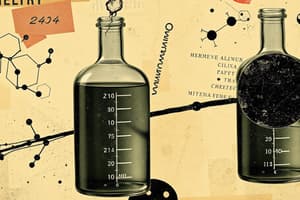Podcast
Questions and Answers
Where are chloride levels typically quite low?
Where are chloride levels typically quite low?
- Mountain supplies (correct)
- Sea waters
- Ground-waters
- River waters
What is used as the titrant in Mohr's method?
What is used as the titrant in Mohr's method?
- Potassium chromate
- AgCl
- Silver nitrate (correct)
- Chloride ions
What concentration of chlorides gives a salty taste to water, making it objectionable to many people?
What concentration of chlorides gives a salty taste to water, making it objectionable to many people?
- 150 mg/L
- 200 mg/L
- 300 mg/L
- 250 mg/L (correct)
What is formed when Ag+ reacts with Cl- in the titration process?
What is formed when Ag+ reacts with Cl- in the titration process?
What is the indicator used in the Mohr's method?
What is the indicator used in the Mohr's method?
In which type of water are chloride levels the highest?
In which type of water are chloride levels the highest?
What forms a reddish brown precipitate in the presence of excess Ag+ during titration?
What forms a reddish brown precipitate in the presence of excess Ag+ during titration?
At what concentration of chlorides, measured in mg/L, does the I.S Public Health Service recommend limits?
At what concentration of chlorides, measured in mg/L, does the I.S Public Health Service recommend limits?
What role does potassium chromate play in the Mohr's method?
What role does potassium chromate play in the Mohr's method?
What occurs to chloride content as the mineral content of natural waters increases?
What occurs to chloride content as the mineral content of natural waters increases?
In what type of water do chloride levels reach very high concentrations due to partial evaporation?
In what type of water do chloride levels reach very high concentrations due to partial evaporation?
What forms as a precipitate when $Ag^+$ reacts with $Cl^-$ in the titration process?
What forms as a precipitate when $Ag^+$ reacts with $Cl^-$ in the titration process?
What color does silver chromate form when it precipitates in the presence of excess $Ag^+$?
What color does silver chromate form when it precipitates in the presence of excess $Ag^+$?
What does the I.S Public Health Service recommend as the maximum chloride concentration in water supplies intended for public use?
What does the I.S Public Health Service recommend as the maximum chloride concentration in water supplies intended for public use?
What is the principle behind using potassium chromate as an indicator in Mohr's method?
What is the principle behind using potassium chromate as an indicator in Mohr's method?
Why is it difficult to detect the end point in the titration without an indicator?
Why is it difficult to detect the end point in the titration without an indicator?
What concentration of chlorides in water is considered unharmful to humans?
What concentration of chlorides in water is considered unharmful to humans?
How are chlorides typically measured in water samples?
How are chlorides typically measured in water samples?
Flashcards are hidden until you start studying
Study Notes
Chloride Occurrence in Natural Waters
- Chloride occurs in all natural waters with varying concentrations.
- The chloride content increases with the mineral content.
- Upland and mountain supplies generally have low chloride levels.
- River and ground-waters typically have a considerable amount of chlorides.
- Sea and ocean waters have very high chloride levels due to partial evaporation of natural waters.
Measurement of Chloride
- Chloride levels can be measured using volumetric procedures with internal indicators.
- Mohr's method is commonly used, employing silver nitrate as the titrant and potassium chromate as the indicator.
- The titration reaction involves the precipitation of chloride ions as white silver chloride.
Titration Endpoint Detection
- The endpoint of the titration cannot be detected by eye without an indicator.
- Potassium chromate is used as the indicator, which forms a reddish-brown precipitate or red color of silver chromate.
Effects of Chloride on Human Health
- Chloride concentrations below 250 mg/L are not harmful to humans.
- Concentrations above 250 mg/L give a salty taste to water, which is objectionable to many people.
- The I.S. Public Health Service recommends limiting chlorides to 250 mg/L in public water supplies.
Chloride in Natural Waters
- Chloride occurs in all natural waters, but its concentration varies widely.
- The chloride content tends to increase as the mineral content increases.
- Upland and mountain water supplies usually have low chloride levels.
- River and groundwater supplies typically have a considerable amount of chlorides.
- Sea and ocean waters have very high chloride levels due to partial evaporation of natural waters flowing into them.
Measurement of Chlorides
- Chlorides can be measured using volumetric procedures with internal indicators.
- Mohr's method is a satisfactory method, which uses silver nitrate as the titrant and potassium chromate as the indicator.
- The titration process involves the precipitation of chloride ions as white silver chloride.
Detection of End Point
- The end point of the titration cannot be detected by eye without an indicator.
- Potassium chromate is used as the indicator, which forms a reddish-brown precipitate or red color of silver chromate.
Health Effects of Chlorides
- Chlorides are not harmful to humans at reasonable concentrations.
- Concentrations above 250 mg/l give a salty taste to water, which is objectionable to many people.
- The I.S. Public Health Service recommends limiting chlorides to 250 mg/l in public water supplies.
Studying That Suits You
Use AI to generate personalized quizzes and flashcards to suit your learning preferences.



